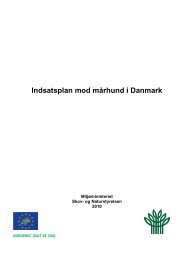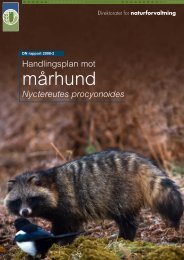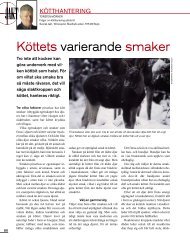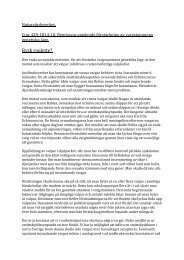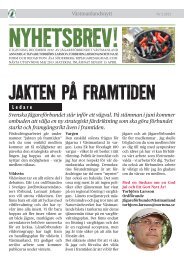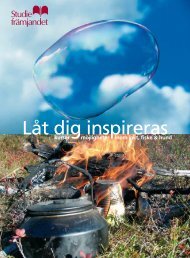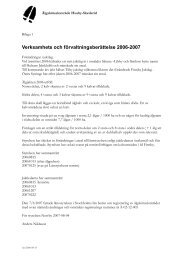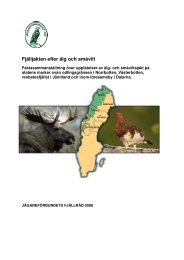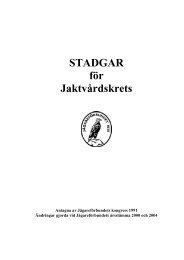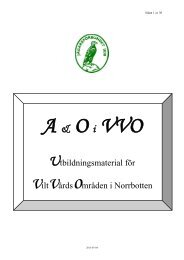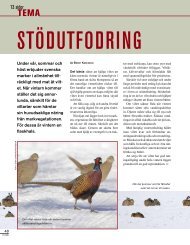Viltforum # 1/2009 Bly från ammunition som förgiftningsrisk hos ...
Viltforum # 1/2009 Bly från ammunition som förgiftningsrisk hos ...
Viltforum # 1/2009 Bly från ammunition som förgiftningsrisk hos ...
Create successful ePaper yourself
Turn your PDF publications into a flip-book with our unique Google optimized e-Paper software.
upphov till en stor fragmentsvärm i ett påskjutet bytesdjur och de fragment <strong>som</strong> kvarlämnas<br />
i räntor (inre organ) <strong>från</strong> ett hjortdjur <strong>som</strong> skjutits i thorax-regionen innehåller tillräckligt<br />
mycket bly för att förgifta flertalet rovfåglar. I Sverige används dock så kallad ”bondad”<br />
kul<strong>ammunition</strong> i relativt stor utsträckning, vilket ger upphov till betydligt mindre fragmentering.<br />
Trots detta förekommer fall där kulfragment påträffats i blyförgiftade havsörnar och<br />
kungsörnar även i Sverige (för mer information om <strong>ammunition</strong> se Appendix 3).<br />
Summary in english<br />
Lead is a toxic heavy metal that is widespread in the environment by human activities. In<br />
the 1950’s the problem with lead poisoned waterbirds was brought to the publics attention by<br />
Bellrose in 1959, when he estimated that approximately 2.5 million waterbirds were killed by<br />
lead poisoning caused by lead shot each year in the United States. Since then, many countries<br />
around the world have reported similar problems, and in many countries, among them<br />
Sweden, have banned the use of lead shot in wetlands.<br />
During recent years a lot of attention has been focused on the poisoning of terrestrial birds by<br />
leaded <strong>ammunition</strong>. Raptors are exposed to lead shot or bullet fragments from shot unrecovered<br />
game or offal. When lead <strong>ammunition</strong> in the form of lead shot or bullet fragments enters<br />
the gastro-intestinal tract, the acidic environment of the stomach causes lead ions to dissolve<br />
from the surface and become bioavailable. Lead <strong>ammunition</strong> in other tissues dissolves slowly<br />
and is not associated with acutely toxic levels. The exposure route of concern for raptorial birds<br />
is therefore intake of lead through the feed.<br />
Metallic lead constitutes the greatest risk for raptorial birds. Studies on raptors fed with tissues<br />
from lead poisoned birds have shown a low absorption of biologically incorporated lead and it<br />
caused no increase in mortality, although <strong>som</strong>e sub-lethal effects could be observed. Lead<br />
poisoning of raptors has been observed in a number of countries in Europe, North America<br />
and Asia. In Sweden lead poisoning has been shown to be a mortality factor for white-tailed<br />
eagles (13.5 %) and golden eagles (8.3 %) Poisoned birds with high levels of lead and classic<br />
symptoms of lead poisoning are frequently found with lead shot or bullet fragments in their<br />
gastro-intestinal tract. Similar lead levels and symptoms can be obtained by experimentally<br />
feeding raptors with lead shot. There are very few indications that any environmental factor,<br />
with the exception of lead-containing <strong>ammunition</strong>, could cause acute lead poisoning in<br />
raptors, with the exception for occasional poisonings caused by lead fishing sinkers.<br />
The ban of lead shot in wetlands has decreased the occurrence of lead shot in egested pellets from<br />
predators in Spain and in North America leading to a decrease of mean lead concentration in blood<br />
from bald and golden eagles. However, there is no significant decrease in the number of cases of<br />
lethal lead poisoning among bald eagles and golden eagles. This is probably a consequence of exposure<br />
to lead shot and bullet fragments originating from hunting of terrestrial birds and mammals.<br />
Studies from the United States have shown that the commonly used expanding bullets undergo<br />
a high degree of fragmentation in shot deer. The offal from a deer shot in the thorax region<br />
contains enough lead to poison several raptors. In Sweden however, a majority of the bullets<br />
sold (70 %) are bonded, which means they will release smaller amounts of fragments upon<br />
impact. Despite this, fragments of lead from <strong>ammunition</strong> are found in the gastro-intestinal<br />
tract in lead poisoned white-tailed and golden eagles in Sweden.<br />
6<br />
<strong>Viltforum</strong> # 1/ <strong>2009</strong><br />
<strong>Bly</strong> <strong>från</strong> <strong>ammunition</strong> <strong>som</strong> <strong>förgiftningsrisk</strong> <strong>hos</strong> rovfåglar - en kunskapsöversikt



